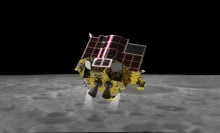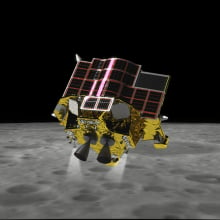The first U.S.-based robotic lander in over a half-century lost its shot at the moon just mere hours into flight.
Pittsburgh-based space robotics company Astrobotic Technologies launched its spacecraft atop a new rocket from Cape Canaveral, Florida, at 2:18 a.m. ET on Jan. 8, in an attempt to be the first company to touch down on the moon. Its lander, named Peregrine after the world's fastest bird, was packed with five NASA payloads among other nations' and commercial customers' cargo.
United Launch Alliance's new Vulcan rocket performed its job without incident for its inaugural voyage. But shortly after the spacecraft became fully operational, Peregrine suffered a serious propulsion problem, unable to point its solar panels at the sun for power. Mission controllers were eventually able to fix Peregrine's orientation, but the propulsion issue caused a critical loss of fuel, rendering much of the journey dead on arrival.
UPDATE: Jan. 9, 2024, 9:46 a.m. EST In a late-night update about the mission, Astrobotic said Monday, Jan. 8, that the ongoing leak is causing Peregrine's compass system to work overtime to keep the spacecraft from tumbling out of control. They estimated Peregrine would run out of fuel in less than two days.
"At this time, the goal is to get Peregrine as close to lunar distance as we can before it loses the ability to maintain its sun-pointing position and subsequently loses power," Astrobotic said on X, formerly Twitter.
Tweet may have been deleted
Astrobotic was set to be the first contractor to make the 250,000-mile trek through NASA's Commercial Lunar Payload Services initiative, a private sector recruitment program to support the U.S. space agency's lunar ambitions. Through several contracts, NASA wants to establish a regular cadence of moon missions to prepare for sending Artemis astronauts back to the moon.
In the new commercial Space Age, failures are not to be unexpected. Though the first uncrewed moon landing happened 60 years ago, getting to the moon and landing is still onerous, with less than half of all missions succeeding. The lunar surface is a veritable graveyard of robotic landers and rovers that didn't fulfill their purposes. For those spacecraft that actually reach lunar orbit, it's still difficult to touch down. The moon's atmosphere is very thin, providing virtually no drag to slow a lander down as it approaches the ground. Furthermore, there are no GPS systems on the moon to help guide a craft to its landing spot.
Thomas Zurbuchen, NASA's former head of science, once described each of these first CLPS endeavors as "taking a shot on goal." The sports analogy means not every attempt will be a victory, but overall the program will help NASA achieve its moon-to-Mars aspirations. By outsourcing NASA's lunar deliveries — rather than owning each mission end-to-end — the agency believes it will save money.
The Peregrine mission cost NASA $108 million.
Tweet may have been deleted
"Today, we don't know how many of the early attempts will be successful," said Joel Kearns, NASA science's deputy associate administrator for exploration, during a news conference in November. "But I can tell you that these American companies are technically strong and rigorous, savvy, they're resourceful, and they're driven to be successful. They want to secure that first mover advantage in generating this new lunar economy."
Several other nations and private companies have recently set their sights on the moon, particularly its south pole, because scientists believe ice is buried in permanently shadowed craters there. The natural resource is coveted because it could supply drinking water, oxygen, and rocket fuel for future missions, ushering a new era in spaceflight.
Next, the Japanese space agency will try to put a lander on the lunar surface. JAXA's spacecraft has been orbiting the moon since Christmas. Its SLIM mission, short for Smart Lander for Investigating the Moon, is expected to touch down near Shioli crater on the moon's near side on Jan. 20.
Astrobotic is expected to deliver NASA's VIPER mission, an ice-mining rover, to the moon later this year. It's not clear how this preceding mission's mishap will impact those plans.
Topics NASA































